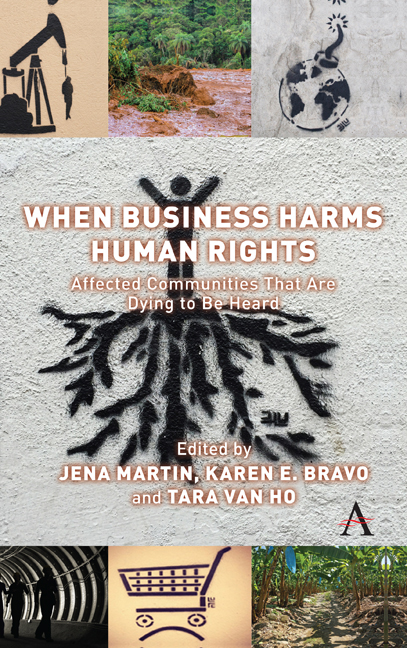Book contents
- Frontmatter
- Contents
- Preface
- Acknowledgements
- Introduction
- Chapter 1 Complicity in False Arrest, Imprisonment and Theft by a Fairtrade-Certified Company
- Chapter 2 Hindrances to Access to a Remedy in Business-Related Cases in Colombia: The Case of Gilberto Torres
- Chapter 3 The Global Pursuit for Justice for DBCP-Exposed Banana Farmers
- Chapter 4 The Rupturing of the Dam and the Community’s Social Fabric: A Testimony from an ‘Atingido’ from Bento Rodrigues, Brazil
- Chapter 5 Taming the Dragon, Unpacking Options for Access to Remedy for Violations by Chinese Multinational Corporations Operating in Chiadzwa, Zimbabwe
- Chapter 6 Máxima Acuña: The Story of How a Business Impacted Human Rights Defenders
- Chapter 7 Community Interrupted, ‘Life Projects’ Disrupted: Cajamarca, Ibagué, and the La Colosa Mine in Colombia
- Chapter 8 Occupational Health as a Human Right: A Case Study in a Turkish Free Trade Zone
- Chapter 9 The Price of the ‘Black Dollar’: Veteran Coal Miners and the Right to Health
- Chapter 10 Abandoned: A Tale of Two Mine Closures in South Africa
- Conclusion
- Appendices
- List of Contributors
- Index
Chapter 4 - The Rupturing of the Dam and the Community’s Social Fabric: A Testimony from an ‘Atingido’ from Bento Rodrigues, Brazil
Published online by Cambridge University Press: 20 January 2022
- Frontmatter
- Contents
- Preface
- Acknowledgements
- Introduction
- Chapter 1 Complicity in False Arrest, Imprisonment and Theft by a Fairtrade-Certified Company
- Chapter 2 Hindrances to Access to a Remedy in Business-Related Cases in Colombia: The Case of Gilberto Torres
- Chapter 3 The Global Pursuit for Justice for DBCP-Exposed Banana Farmers
- Chapter 4 The Rupturing of the Dam and the Community’s Social Fabric: A Testimony from an ‘Atingido’ from Bento Rodrigues, Brazil
- Chapter 5 Taming the Dragon, Unpacking Options for Access to Remedy for Violations by Chinese Multinational Corporations Operating in Chiadzwa, Zimbabwe
- Chapter 6 Máxima Acuña: The Story of How a Business Impacted Human Rights Defenders
- Chapter 7 Community Interrupted, ‘Life Projects’ Disrupted: Cajamarca, Ibagué, and the La Colosa Mine in Colombia
- Chapter 8 Occupational Health as a Human Right: A Case Study in a Turkish Free Trade Zone
- Chapter 9 The Price of the ‘Black Dollar’: Veteran Coal Miners and the Right to Health
- Chapter 10 Abandoned: A Tale of Two Mine Closures in South Africa
- Conclusion
- Appendices
- List of Contributors
- Index
Summary
This chapter will cover the life stories of ‘Atingidos’, or those ‘victims’ of the Bento Rodrigues dam disaster, owned by Samarco mining company in south-eastern Brazil. Samarco is a joint venture between the world's largest mining company BHP Billiton (headquartered in Australia) and Vale, another one of the largest mining companies in the world (headquartered in Brazil). Both multinationals are members of prestigious corporate social responsibility initiatives such as the United Nations Global Compact initiative and the International Council for Mining and Metal (ICMM). BHP is currently ranked third by the Corporate Human Rights Benchmark (CHRB), while Vale was ranked in sixth place until 28 January 2019 after its second fatal dam collapse in Brumadinho also in Minas Gerais state, Brazil, where 249 fatalities had been recorded by end of August 2019.
The bursting of the Fundão dam has been described as the worst environmental disaster in Brazil's history. The disaster occurred on 5 November 2015, when the Fundão tailings dam in Bento Rodrigues (a village located within the municipality of Mariana, Brazil) broke. Within 60 minutes of the collapse, 35 billion tonnes of iron-ore reject and mud had engulfed and destroyed the nearby village; the devastation continued for the next 668 km, sweeping away everything in its path until it reached the Atlantic Ocean coast. All told, the disaster took the lives of 19 people and negatively impacted 23,000 other families.
Scientific studies claim that 90 per cent of the Doce River basin that was affected by the dam burst was still contaminated two years later.
The company denies responsibility for the collapse of the dam despite a 2013 report from the Brazilian authorities stating that there were structural weaknesses in the dam. According to a Wall Street Journal report, the company had been warned in 2014 about the severe structural cracks to the dam, which the company claims it had addressed. Regional and national Brazilian courts are attempting to prosecute 21 Samarco executives for homicide related to the rupture of the Fundão dam. Originally, the Brazilian government stated that it would fine Samarco R $250 million (US$66.3 million) for the incident.
- Type
- Chapter
- Information
- When Business Harms Human RightsAffected Communities that Are Dying to Be Heard, pp. 57 - 70Publisher: Anthem PressPrint publication year: 2020

